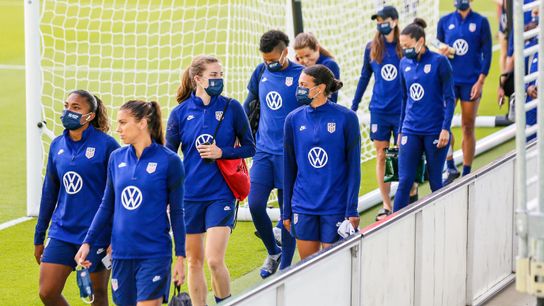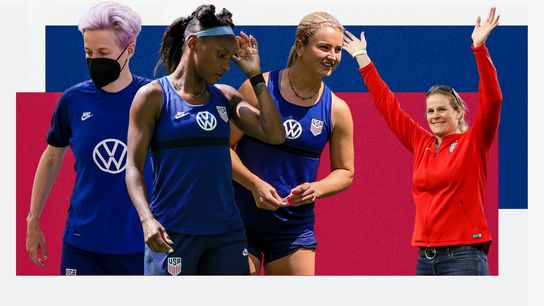On the pitch, women’s and men’s soccer are the same game. Off the pitch, there’s quite a lot of discrepancies. The intricacies of the business of soccer isn’t for everyone, but it is crucial for a full understanding of the sport to know the nuances and politics behind the women’s game.
In March 2018, 28 U.S. women’s national team (USWNT) players filed a class action lawsuit against the U.S. Soccer Federation (USSF) over "institutionalized gender discrimination". As the USWNT prepares to cut the ribbon on Q2 stadium, the case is still being battled in the courts.
On Tuesday June 15th 2021, Cindy Cone, president of the USSF, addressed the media to attempt to build bridges with the USWNT. “We as a federation need to do what's right by the players of today,” said Cone. "I am committed to equal pay, and all of U.S. Soccer is committed to equal pay."
With no end in sight, and the next high-profile tournament quickly approaching, the fight for equal pay continues.
For the non-indoctrinated, here's how USWNT works:
How do national team contracts work?
The biggest single difference between the USWNT and the U.S. Men’s national team(USMNT) is the respective salaried contract system versus bonus structure system that are currently in place.
USWNT players receive a direct salary from the USSF. This base salary is said to be around $90,000-$100,000 per year. Currently 22 USWNT players are essentially signed to their national team on this type of year-long contract and then allocated out at no additional cost to their respective NWSL clubs.
USMNT team players do not get paid annual salaries from the USSF. They only get paid when they feature for the national team in international friendlies and competitions. This salary structure for the USMNT is known as "pay-per-play." This is said to be about $5,200 for a single friendly match appearance, much higher for top 25 ranked opponents and even more for tournaments.
The men’s team also typically have far greater bonus earnings for winning than the women’s team. If one uses the respective 2018 and 2019 World Cups as a case study: each USMNT player would have received $1.14m from the USSF for winning the 2018 World Cup in their current bonus pay structure. In comparison, after the USWNT successfully won the 2019 World Cup, the USSF paid each member of the roster $260,860 (data via The Guardian).
Along with equal treatment, access to practice facilities and accommodation resources, this is where the brunt of the equal pay debate lies.
What is the relationship like between the USSF and NWSL?
People have mixed feelings on this. On the one hand, the USSF contract allocation structure has kept many USWNT players from being a financial burden on their NWSL clubs. The household names of the national team have been able to use their high profile to help grow the U.S. domestic league without sacrificing income.
One has to remember that two former professional women’s soccer leagues have folded in the U.S. before: the WUSA in 2003 and the WPSL in 2012. In contrast, a healthy and growing NWSL in its ninth season is encouraging. The USSF deal has provided stability, even if it has limited the amount of autonomy that NWSL clubs can have over their players.
Alternatively, some people believe that the USSF contract structure actually dilutes the competitiveness and control of the NWSL clubs. On the league's side, if their players are free to move clubs every year or go on loan to Europe with nothing in return, are they really part of their NWSL team? For players, how much financial and professional security is there in knowing your club future could be so impermanent?
The power that the USSF wields has led many to question the ambition of the NWSL.
How do you sign a USWNT player in the NWSL?
When the NWSL began in 2013, the USWNT players were drafted out, team by team. Now the national team players’ “rights” are traded from club to club on one-year contracts, but their salaries are maintained by the USSF. Every year in January, the USSF renews their list of all allocated USWNT and the NWSL reacts accordingly. For example, in January 2021, Kristie Mewis became an allocated USWNT player. The Houston Dash held onto her playing "rights" but no longer picked up her base salary.
During expansion drafts, of which there have been three (2014, 2016 and 2020) and another scheduled for 2022, each team has only been allowed to protect a maximum of two USWNT players on their roster. Thus the USWNT talent pool continues to spread across the NWSL.
This idealist process can backfire from time to time. In November of 2020, Racing Louisville drafted USWNT players Christen Press and Tobin Heath, but they are yet to report to the club. As odd as that might sound, they technically don't have to. They've signed no contract with Louisville and the USWNT pays their salary.
"We've tried, we've tried. That's all I can say," said Louisville head coach Christy Holly when asked about the duo in May 2021.
Let's make a proper introduction...
— Racing Louisville FC (@RacingLouFC) November 13, 2020
More on tonight's 14 selections in the @NWSL expansion draft 👉 https://t.co/XRtLxnHEBt pic.twitter.com/huDgGdguS1
Would a player ever choose not to be contracted to the USSF?
Yes. This is a fairly new phenomenon, but there is a recent trend of players opting out of the traditional USWNT contract model. Lindsey Horan and Crystal Dunn of the Portland Thorns are the players to transcend the USSF model. Horan and Dunn are now both said to each be earning $125,000 (reports The Athletic) on multi-year contracts directly from the Thorns, because they are receiving NWSL allocation money.
In addition to being contracted to an NWSL team with more long-term guarantees, they can also access a more lucrative bonus structure from the USSF, whilst still earning a top tier salary from their NWSL club. This cultural shift in contract trends has occurred because the rules surrounding NWSL allocation money changed ahead of the 2021 season. Before 2021, you could not pay USWNT or Canadian national team players allocation money, but that is no longer the case.
What is NWSL allocation money and why did they change the rules?
Allocation money enables NWSL teams to invest a capped amount of funds into current or future players. Starting in 2020, teams were allowed to use up to $300,000 in allocation money. That figure has risen to $400,000 in 2021. Some teams choose to trade the allocation money to other teams in exchange for players. In this case, the allocation money becomes a transfer fee that the receiving team can either trade on or use on player salaries.
Each team in the NWSL has a salary cap of $682,500 per 24-28 player roster. The salary per player is set at a minimum of $22,000 and a maximum of $52,000. You can then use NWSL allocation money, limited to $400,000, to pay a player an excess of the league maximum (e.g. Horan and Dunn), and essentially break the salary cap.
The rule change has encouraged NWSL clubs to pay a competitive salary more aligned with top international leagues, which in turn helps keep the USWNT players in the NWSL instead of choosing to go and play in other leagues. It also helps NWSL teams have more control and foresight over the USWNT players they want on their roster.

Do the USSF ever overrule NWSL clubs?
All the time. Unless there is going to be major systemic changes to the entire U.S. soccer landscape, the season will always take place between late spring and late fall. That means major tournaments, like World Cups and Summer Olympics, will always happen during the NWSL season. Attention in the U.S. domestic league currently fluctuates as marquee names head off to play elsewhere during the season.
Furthermore, minutes restrictions are commonplace for the USWNT players as they prioritize playing for their country over playing for their club, even when they are not absent due to a USWNT training camp.
Since 2019, Megan Rapinoe has played almost three times as many minutes for the USWNT as she has done for her club team OL Reign. During the 2020 season, Rose Lavelle was only allowed to play 30 minutes per match for the Washington Spirit.
Rose Lavelle's goal in the World Cup final was fun to watch again. Thanks FS1. pic.twitter.com/K5oMIPPess
— Grant Wahl (@GrantWahl) March 21, 2020
“We had no real choice on the matter,” said Spirit head coach Richie Burke when discussing the restrictions put in place by the USSF.
What next for the USSF and NWSL?
The rest is still unwritten.
The USWNT are currently back-to-back World Cup champions, undefeated in 41 matches and are favorites to bring home Olympic gold in Tokyo the summer. Regardless of what the verdict and/or settlement of the equal pay lawsuit against the USSF is, the attention and conversation the national team has brought to the equal pay debate is significant.
The players' current collective bargaining agreement (CBA) will expire after the Olympics. That is when the microscope will be on the USSF to see how they restructure what it means to be a USWNT player. This tectonic shift on the horizon will, of course, cause shockwaves in the NWSL in 2022.
The NWSL has steadily asserted itself as one of the premier women's soccer leagues in the world. Next season the league will expand to 12 teams, with Los Angeles and San Diego joining the league. As California goes from zero NWSL teams to two, the clamor for Texas to do the same intensifies.
The upcoming CBA could determine what the landscape looks like for more expansion or even trigger a new dawn where the majority of USWNT players are signing deals with NWSL teams or even abroad in foreign leagues.
A Big West Coast Welcome ☀️🌴@SanDiegoNWSL makes it official ⤵️
— National Women's Soccer League (@NWSL) June 8, 2021
